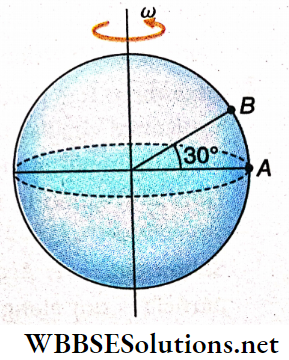Circular Motion
WBBSE Class 11 Circular Motion Notes
A Material Particle May Possess Two Kinds Of Motion:
- Translational motion and
- Circular or rotational motion.
Sometimes the particle may possess both kinds of motion simultaneously. This is known as a mixed motion. We have already discussed translational motion elaborately in the chapter on One-dimensional Motion.
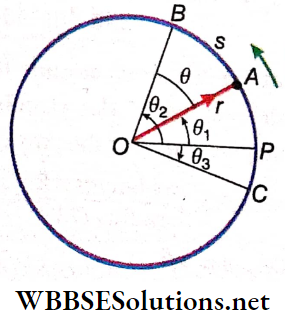
Circular Motion Definition: If a particle is moving along a circular path about a point as the centre then the motion of that particle is called circular or rotational motion.
- The surface in which the circular path lies is called the plane of rotation. A straight line drawn through the centre of the circular path and perpendicular to the plane of rotation is called the axis of rotation.
- Let us consider a particle is revolving along a circular path of radius r and centre O. The perpendicular drawn through the point O on the plane of rotation is the axis of rotation.
Read and Learn More: Class 11 Physics Notes
- The radius r of the circle is called the radius vector whose direction is towards the particle away from the centre. During the revolution of the particle, the radius vector also keeps on rotating.
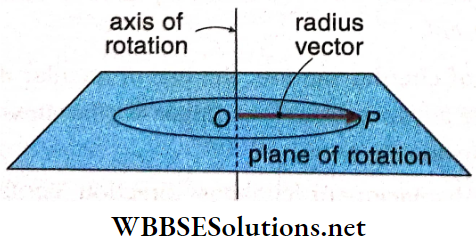
Angular Coordinate: Let OP be the radius of the circle, and be taken as the reference for rotation i.e., at time t = 0, the position of the particle is at point P. Let us assume that the position of the particle is at point A on the circumference of the circle after time t and the arc AP makes an angle θ1 with OP at the centre O.
- This angle θ1 is called the angular coordinate for the position A of the particle with respect to the radius OP. Similarly, the angular coordinates of the points B and C are θ2 and -θ3, respectively.
- So, the position of the particle on a particular circular path can be determined from its angular coordinate only. It should be noted that the angular coordinate for position C in the given figure is negative.
- Usually, for anticlockwise rotational motion, θ is taken as positive and for clockwise motion, negative.
Angular Acceleration
Key Concepts of Circular Motion in Physics
Angular Acceleration Definition: The rate of change of angular velocity of a particle with time is called the angular acceleration of that particle.
Let us consider a particle under rotational motion whose initial angular velocity is ω1 and final angular velocity after time t is ω2. So, according to the definition
angular acceleration (α) = \(\frac{\text { change in angular velocity }}{\text { time }}\)
= \(\frac{\omega_2-\omega_1}{t}\)
Compared with the definition of average acceleration in the chapter One-dimensional Motion, this can be referred to as the average angular acceleration.
Instantaneous angular acceleration: The instantaneous angular acceleration of a particle at a given point is the limiting value of the rate of the change in velocity with respect to a time interval when the time interval tends to zero.
If the change in angular velocity of a particle in a small time interval Δt is Δω, then instantaneous angular acceleration,
α = \(\alpha=\lim _{\Delta t \rightarrow 0} \frac{\Delta \omega}{\Delta t}=\frac{d \omega}{d t} .\)
Since, \(\omega=\frac{d \theta}{d t}, \alpha=\frac{d}{d t}\left(\frac{d \theta}{d t}\right)=\frac{d^2 \theta}{d t^2}\)
If the angular velocity of a particle increases gradually, the particle is said to be moving with an angular acceleration.
For example, when an electric fan is switched on, it undergoes angular acceleration before attaining its velocity.
On the other hand, if the angular velocity of a body decreases gradually, it is said to be moving with an angular deceleration or angular retardation. For example, when an electric fan is switched off, it undergoes angular deceleration until it stops.
In the case of angular retardation, the initial angular velocity ω1 is greater than the final angular velocity ω2.
Hence, \(\alpha=\frac{\omega_2-\omega_1}{t}\) = a negative quantity.
So, angular retardation is nothing but a negative angular acceleration.

Angular Acceleration Is An Axial Vector: As \(\vec{\omega}_1\) and \(\vec{\omega}_2\) are axial vectors, \(\vec{\omega}_2\) – \(\vec{\omega}_1\) and, hence, \(\vec{\alpha}\) is also an axial vector. When \(\vec{\alpha}\) is positive, its direction is the same as that of \(\vec{\omega}\) and when \(\vec{\alpha}\) is negative, its direction is opposite to that of \(\vec{\omega}\).
Uniform vs Non-Uniform Circular Motion
Unit And Dimension Of Angular Acceleration: Unit of angular acceleration
= \(\frac{\text { unit of angular velocity }}{\text { unit of time }}\)
= \(\mathrm{radian} / \mathrm{second}{ }^2=\left(\mathrm{rad} \cdot \mathrm{s}^{-2}\right)\)
Dimension of angular acceleration = \(\frac{\text { dimension of angular velocity }}{\text { dimension of time }}=\frac{T^{-1}}{T}=T^{-2} \text {. }\)
Relation Between Linear Acceleration And Angular Acceleration: Let us consider a particle moving along a circular path of radius r, whose linear velocity changes from \(\vec{v}_1 \text { to } \vec{v}_2\) in time t. During this time interval, its angular velocity changes from \(\vec{\omega}_1\) to \(\vec{\omega}_2\).
∴ \(\vec{v}_1=\vec{\omega}_1 \times \vec{r}\) and \(\vec{v}_2=\vec{\omega}_2 \times \vec{r}\)
∴ The value of linear acceleration, \(\vec{a}=\frac{\vec{v}_2-\vec{v}_1}{t}=\frac{\left(\vec{\omega}_2 \times \vec{r}\right)-\left(\vec{\omega}_1 \times \vec{r}\right)}{t}=\frac{\left(\vec{\omega}_2-\vec{\omega}_1\right)}{t} \times \vec{r}\)
Again, angular acceleration is, \(\vec{\alpha}=\frac{\vec{\omega}_2-\vec{\omega}_1}{t}\)
∴ \(\vec{a}=\vec{\alpha} \times \vec{r}\)
Thus, the magnitude of instantaneous linear acceleration = the magnitude of instantaneous angular acceleration x radius of the circular path.
It should be remembered that in the case of pure rotation, linear acceleration changes its direction continuously, but the direction of angular acceleration remains unaltered. Whenever the axis of rotation remains fixed, the direction of angular acceleration does not change.
Geometrical Representation: Putting \(\vec{a} \text { and } \vec{\alpha}\) instead of \(\vec{v} \text { and } \vec{\omega}\), respectively, we will obtain the geometrical representation for the relation among \(\vec{a}\), \(\vec{\alpha}\) and \(\vec{r}\).
Kinematical Equations Of Rotational Motion
From the analogy of the three equations s = θ, v = rω and a = rα, it can be inferred that in case of rotational motion, angular displacement θ, angular velocity co and angular acceleration α, respectively, play the same role as that of displacement s, velocity v and acceleration a in the case of translational motion.
For this reason θ, ω and α are called the rotational analogues of s, v and a respectively. (If a quantity has similarities with another quantity, then that quantity is called the analogue of the other.)
Kinematical Equations For Uniformly Accelerated Motion Are:
- v = u + at
- s = ut + 1/2at²
- v² = u² + 2as
For a uniformly accelerated rotational motion, the analogues of these equations are:
- \(\omega_2=\omega_1+\alpha t\)
- \(\theta=\omega_1 t+\frac{1}{2} \alpha t^2\)
- \(\omega_2^2=\omega_1^2+2 \alpha \theta\)
Here, initial angular velocity = ω1, final angular velocity after time t = ω2, angular acceleration = α and angular displacement after time t = θ.
In the case of translational motion with uniform velocity, s = vt. In the case of uniform rotational motion, the analogue of this equation is θ= ωt.
Comparison Of Linear And Angular Motion With Constant Acceleration:
- Straight Line Motion With Constant Linear Acceleration: For an object that starts moving along a straight line with initial velocity u and constant linear acceleration a, we have
- a =constant,
- v= u+at,
- s =ut+ 1/2at²,
- v² = u² + 2as
- Fixed Axis Rotation With Constant Angular Acceleration: For an object that starts revolving with initial angular velocity ω0 and uniform angular acceleration α, we have
- \(\alpha\) = constant,
- \(\omega_1=\omega_0+\alpha t\),
- \(\theta=\omega_0 t+\frac{1}{2} \alpha t^2\),
- \(\omega^2=\omega_0^2+2 \alpha \theta\)
Kinematical Equations Of Rotational Motion Numerical Examples
Short Answer Questions on Circular Motion
Example 1. An electric fan is revolving with a velocity of 210 rpm. When its morion Is Increased with the help of a regulator, it attains a velocity of 630 rpm in 11 s. What is the angular acceleration of the fan? Also, calculate the number of revolutions completed by the fan in that 11s.
Solution:
Given
An electric fan is revolving with a velocity of 210 rpm. When its morion Is Increased with the help of a regulator, it attains a velocity of 630 rpm in 11 s.
Initial angular velocity, \(\omega_1=\frac{2 \pi \times 210}{60}=7 \pi \mathrm{rad} \cdot \mathrm{s}^{-1}\)
Final angular velocity, \(\omega_2=\frac{2 \pi \times 630}{60}=21 \pi \mathrm{rad} \cdot \mathrm{s}^{-1}\)
Now, from the equation ω2 = ω1+ αt we get, angular acceleration,
α = \(\frac{\omega_2-\omega_1}{t}=\frac{21 \pi-7 \pi}{11}=\frac{14 \pi}{11}=\frac{14}{11} \times \frac{22}{7}\)
= \(4 \mathrm{rad} \cdot \mathrm{s}^{-2}\)
Again, angular displacement, \(\theta=\omega_1 t+\frac{1}{2} \alpha t^2=7 \pi \times 11+\frac{1}{2} \times 4 \times(11)^2\)
θ = \(11(7 \pi+22)=484 \mathrm{rad}\)
Since in a single revolution, the angular displacement is 2π, the number of revolutions
= \(\frac{\theta}{2 \pi}=\frac{484}{2 \pi}=77\)
Example 2. A wheel rolls on a horizontal path with uniform velocity. Prove that the velocity of any point on the circumference of the wheel with respect to its centre is equal to the velocity of the wheel What will be the instantaneous velocity of the point on the wheel which touches the ground?
Solution:
A wheel rolls on a horizontal path with uniform velocity.
If the radius of the wheel is r then its circumference = 2πr, and velocity of the wheel = \(\frac{2 \pi r}{T}=\frac{2 \pi r}{\frac{2 \pi}{\omega}}=\omega r\)
here, ω = angular velocity of the wheel
Again, the linear velocity of any point on the circumference of the wheel with respect to its centre is, v = ωr. So, this velocity is the same as the velocity of the wheel.
At any moment, when a point on the wheel touches the ground, its linear velocity with respect to the centre of the wheel is v and its direction is just opposite to the direction of the linear velocity v of the wheel Hence, the instantaneous resultant velocity of the point on the wheel which touches the ground = v-v = 0.
| Class 11 Physics | Class 12 Maths | Class 11 Chemistry |
| NEET Foundation | Class 12 Physics | NEET Physics |
Example 3. Starting from rest, a wheel, with uniform acceleration, attains an angular velocity of 60 rad · s-1 at the end of 30 complete revolutions. What Is the angular acceleration of the wheel?
Solution:
Given
Starting from rest, a wheel, with uniform acceleration, attains an angular velocity of 60 rad · s-1 at the end of 30 complete revolutions.
Initial angular velocity, ω1 =0.
Angular displacement at the end of 30 revolutions, θ = 30 x 2π = 60π rad
Final angular velocity, ω1 = 60 rad · s-1
Now, from the equation \(\omega_2^2=\omega_1^2+2 a \theta\)
(α = angular acceleration of the wheel) we get, (60)2 = 0 + 2a x 60/r
or, \(\alpha=\frac{30}{\pi}=9.55 \mathrm{rad} \cdot \mathrm{s}^{-2} .\)
Circular Motion Conclusion
Centripetal Force and Circular Motion
If any particle moves along a circular path about a point as the centre, then the motion of that particle is called circular motion or rotational motion.
- The angle subtended by the initial and final positions of a rotating particle at the centre of its path is called the angular displacement of the particle.
- Angular displacement is a dimensionless physical quantity.
- The rate of angular displacement of a particle with time is called the angular velocity of the particle.
- The rate of change of angular velocity of a particle with time is called the angular acceleration of the particle.
- If the angular velocity of a particle rotating along a circular path is constant, its motion is known as uniform circular motion.
When an object moves in a circular path with a varying speed, then the motion of the object is called non-uni-form circular motion.
There are two unit vectors of circular motion. One is the radial unit vector and the other is the tangential unit vector. The radial unit vector is directed along the radius of the circular path away from the centre.
- The tangential unit vector is directed along the tangent of the circular path. There are two components of the acceleration in non-uniform circular motion. One is radial acceleration and the other is tangential.
- In the case of a particle revolving along a circular path with uniform speed i.e., in the case of uniform circular motion, the acceleration which always acts towards the centre of the circle, known as the radial or centripetal or normal acceleration.
- The force that acts normally to the direction of its velocity to rotate a body along a circular path and is directed towards the centre of that circular path from the body along the radius of the circle is called the centripetal force.
If an observer rotates with a body with the same angular velocity as that of the body rotating along a circular path, the observer will feel that a force is acting on this body which is equal but opposite in direction to the centripetal force. This force is called the centrifugal force.
Circular Motion Useful Relations For Solving Numerical Examples
1° = π/100 rad or, 1 rad = 57.296°
Distance travelled by a rotating particle (s) = radius of the path (r) x angular displacement(θ)
While revolving along a circular path, if the angular displacement of a particle is θ in time f, then the average angular velocity of the particle, \(\omega=\frac{\theta}{t}\)
If in a time interval Δt, the angular displacement of a particle is Δθ0, then the instantaneous angular velocity, \(\omega=\lim _{\Delta t \rightarrow 0} \frac{\Delta \theta}{\Delta t}=\frac{d \theta}{d t}\)
1 rpm = \(\frac{\text { one complete revolution }}{1 \text { minute }}=\frac{2 \pi}{60} \mathrm{rad} \cdot \mathrm{s}^{-1}\)
= \(\frac{\pi}{30} \mathrm{rad} \cdot \mathrm{s}^{-1}\)
Angular Velocity in Circular Motion
The value of linear velocity at any moment (v) = value of angular velocity (ω) at that moment x radius of the circular path (r)
If the initial angular velocity of a rotating particle be ω1 and that after time t is ω2, then angular acceleration (a) = \(\frac{\omega_2-\omega_1}{t}\)
Value of instantaneous linear acceleration (a) = radius of the circular path (r) x value of instantaneous angular acceleration (α)
Equations for pure circular motion of a particle with uniform angular acceleration are
- \(\omega_2=\omega_1+\alpha t\)
- \(\theta=\omega_1 t+\frac{1}{2} \alpha t^2\)
- \(\omega_2^2=\omega_1^2+2 \alpha \theta\)
Here, initial angular velocity = ω1, final angular velocity after time t = ω2, angular acceleration = α and angular displacement in time t = d.
If a particle of mass m revolves along a circular path of radius r with uniform speed v, the normal or centripetal acceleration of the particle = \(\omega^2 r=\frac{v^2}{r}\)(ω = angular velocity of the particle, ω = \(\frac{v}{r}\))
If the mass of the body is m, the radius of its circular path is r, its linear velocity is v and its angular velocity is ω, then centrifugal force = \(m \omega^2 r=\frac{m v^2}{r}\)
If a body of mass m revolves along a circular path of radius r with velocity v (angular velocity ω), then centrifugal force = \(\frac{m v^2}{r}=m \omega^2 r\)
Circular Motion Assertion Reason Type Question And Answers
Applications of Circular Motion in Real Life
These questions have statement 1 and statement 2. Of the four choices given below, choose the one that best describes the two statements.
- Statement 1 Is true, statement 2 Is true; statement 2 is a correct explanation for statement 1.
- Statement 1 Is true, and statement 2 Is true; statement 2 is not a correct explanation for statement 1.
- Statement 1 is true, statement 2 is false,
- Statement 1 Is false, and statement 2 is true.
Question 1.
Statement 1: A pendulum is oscillating between points A, B and C. Acceleration of bob at points A or C is zero.
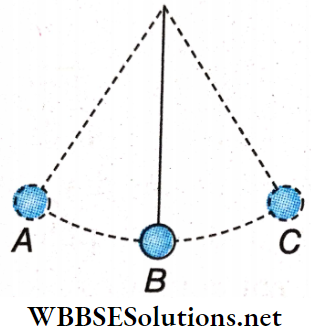
Statement 2: Velocity at A and C is zero.
Answer: 4. Statement 1 Is false, and statement 2 is true.
Question 2.
Statement 1: A particle of mass m undergoes uniform horizontal circular motion inside a smooth funnel as shown, The Normal reaction in this case is not mgcosθ.
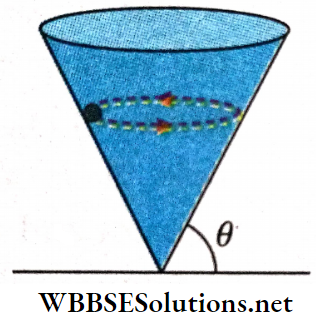
Statement 2: Acceleration of particle is not along the surface of the funnel.
Answer: 1. Statement 1 Is true, statement 2 Is true; statement 2 is a correct explanation for statement 1.
Question 3.
Statement 1: If a car is taking a turn on a banked road, then the normal contact force between the car and the road is greater than the weight of the car (neglecting friction).
Statement 2: On a banked road, the horizontal component of normal contact force between the car and the road provides the necessary centripetal force. Assume friction is absent.
Answer: 2. Statement 1 is true, statement 2 is false,
Question 4.
Statement 1: A car takes a turn of radius 20 m with a constant velocity of 10 m · s-1.
Statement 2: In circular motion, velocity can never be constant.
Answer: 4. Statement 1 Is false, and statement 2 is true.
Question 5.
Statement 1: A particle can perform circular motion without having any tangential component of acceleration.
Statement 2: For circular motion to take place, radial acceleration should exist.
Answer: 2. Statement 1 Is true, and statement 2 Is true; statement 2 is not a correct explanation for statement 1.
Question 6.
Statement 1: Uniform circular motion is uniformly accelerated motion.
Statement 2: Acceleration in uniform circular motion is always towards the centre.
Answer: 4. Statement 1 Is false, and statement 2 is true.
Question 7.
Statement 1: In circular motion average speed and average velocity are never equal.
Statement 2: In any curvilinear path these two are never equal.
Answer: 1. Statement 1 Is true, statement 2 Is true; statement 2 is a correct explanation for statement 1.
Circular Motion Match Column A With Column B
Question 1. In Column A some physical quantities related to translational motion are given, while in Column B physical quantities associated with rotational motion are mentioned.
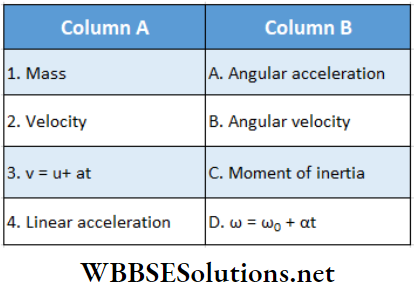
Answer: 1. C, 2. B, 3. D, 4. A
Question 2. A particle is rotating in a circle of radius R = \(\frac{2}{\pi}\)m, with constant speed 1 m • s-1. Match the following two columns for the time interval when it completes 1/4 th of the circle.
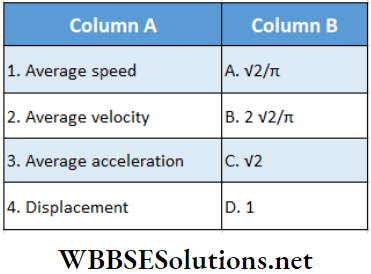
Answer: 1. D, 2. B, 3. C, 4. B
Circular Motion Comprehension Type Question And Answers
Read the following passages carefully and answer the questions at the end of them.
Question 1. A particle is moving along a circular path of radius 0.7 m with constant tangential acceleration of 5 m · s-2. The particle is initially at rest. Based on the above information, answer the following questions
1. The speed of the particle after 7 s is
- 5 m • s-1
- 7 m • s-1
- 35 m • s-1
- 48 m • s-1
Answer: 3. 35 m • s-1
2. The radial acceleration of the particle at t = 7 s is
- 1200 m · s-2
- 1750 m · s-2
- 70 m · s-2
- 250 m · s-2
Answer: 2. 1750 m · s-2
3. Distance travelled by the particle in 7 s is
- 123 m
- 725 m
- 728 m
- 426 m
Answer: 1. 123 m
4. The number of revolutions made by the particle in 7 s is
- 27.8
- 164.8
- 165.52
- 96.85
Answer: 1. 27.8
Question 2. A small particle of mass m attached with a light inextensible thread of length L is moving in a vertical circle. In the given case the particle is moving in a complete vertical circle and ratio of its maximum to minimum velocity is 2: 1.
1. Minimum velocity of the particle is
- \(\sqrt[4]{\frac{g L}{3}}\)
- \(2 \sqrt{\frac{g L}{3}}\)
- \(\sqrt{\frac{g L}{3}}\)
- \(3 \sqrt{\frac{g L}{3}}\)
Answer: 2. \(2 \sqrt{\frac{g L}{3}}\)
2. The kinetic energy of the particle at the lowest position is
- \(\frac{4 m g L}{3}\)
- \(2 m g L\)
- \(\frac{8 m g L}{3}\)
- \(\frac{2 m g L}{3}\)
Answer: 3. \(\frac{8 m g L}{3}\)
3. The velocity of the particle when it is moving vertically downward is
- \(\sqrt{\frac{10 g L}{3}}\)
- \(2 \sqrt{\frac{g L}{3}}\)
- \(\sqrt{\frac{8 g L}{3}}\)
- \(\sqrt{\frac{13 g L}{3}}\)
Answer: 1. \(\sqrt{\frac{10 g L}{3}}\)
Question 3. The earth rotates once per day about an axis passing through the north and south poles, that is perpendicular to the plane containing the equator. Assume the earth as a sphere of radius 6400 km. The two particles A and B are considered on the surface of the earth as shown. The particle A is situated at the equator and B is situated at a latitude of 30° north of the equator.
1. The speed of particle A is
- 465.4 m · s-1
- 850 m · s-1
- 243.6 m · s-1
- 1.675 x 106 m · s-1
Answer: 1. 465.4 m · s-1
2. The acceleration of particle A is
- 3.38 x 10-7 m · s-2
- 3.38 x 10-5 m · s-2
- 3.38 x 10-2 m · s-2
- 3.38 x 10-1 m · s-2
Answer: 3. 3.38 x 10-2 m · s-2
3. The speed of particle B is
- 405 m · s-1
- 403 m · s-1
- 706.5 m · s-1
- 210 m · s-1
Answer: 2. 403 m · s-1
Circular Motion Integer Answer Type Questions
In this type, the answer to each of the questions is a single-digit integer ranging from 0 to 9.
Question 1. A particle is moving along a circular path of radius 2 m with a constant angular velocity of 3 rad • s-2. Determine the angular displacement (in rad) of the particle in 3 s.
Answer: 9
Question 2. A particle moves in a circle of radius 1.0 cm at a speed given by v = 2.0t, where v is in cm · s-1 and t in seconds. Find the radial acceleration of the particle at t = 1s.
Answer: 4
Question 3. If the earth was to suddenly contract to half its present size, without any change in its mass, then what would be the duration of the new days (in hours)?
Answer: 6
